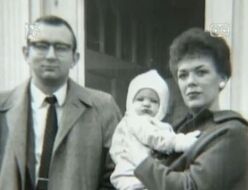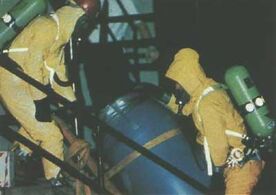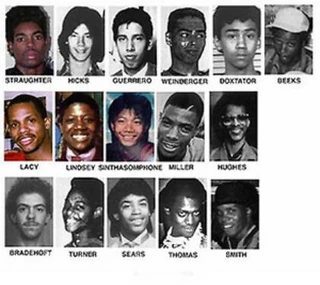| “ | After the fear and terror of what I'd done had left, which took about a month or two, I started it all over again. From then on it was a craving, a hunger, I don't know how to describe it, a compulsion, and I just kept doing it, doing it and doing it, whenever the opportunity presented itself. | ” |
— Dahmer
| ||
Jeffrey Lionel Dahmer, sometimes nicknamed "The Milwaukee Cannibal", was an American necrophilic, ephebophilic, hebephilic, and cannibalistic serial killer, serial rapist, and poisoner.
Background

An infant Dahmer with his parents.
Dahmer was born in West Allis, Wisconsin, on May 21, 1960. His parents were Lionel Herbert Dahmer, a chemical analyst, and Joyce Dahmer. Seven years later, his brother, David, was born. By all accounts, Jeffrey had a normal childhood, though his parents' marriage is said to have been tense and he was often left to himself since they were often busy with work. He became very mellowed after he was operated on for a double hernia when he was six years old. It has also been claimed that he was molested by a neighbor. As he got older, he grew increasingly introverted and began spending time at a secret animal cemetery he had built himself and filled with roadkill, the centerpiece of which was a dog's head he had placed on a stake. He began drinking in his teens and was a full-blown alcoholic by high school. In 1977, his parents divorced and he very briefly attended Ohio State University before dropping out due to his drinking.
Murders, Arrest, Trial, Incarceration, and Death
On June 6, 1978, Dahmer committed his first murder. While living alone in the family home, Dahmer invited an 18-year-old hitchhiker named Steven Hicks for drinks. After several hours of drinking, Hicks wanted to leave and Dahmer did not want him to. When he tried to leave, Dahmer bludgeoned and strangled him to death with a barbell and buried the body near his pet cemetery. Sometime after that, Dahmer's father compelled him to join the Army, where he rated average. He was trained as a medic and deployed to West Germany, but was honorably discharged in 1981 due to his alcoholism. When this happened, he was provided by the Army an airplane ticket to anywhere in the country, which he used to go to Miami Beach, Florida. He spent most of his time there at a hospital but was eventually kicked out because of his drinking. He continued doing so when he came home, eventually being arrested for drunk and disorderly conduct later in 1981.

Dahmer's apartment sealed off by police
In 1982, Dahmer moved in with his grandmother in West Allis. While he lived there, she found, on different occasions, a fully dressed male mannequin stolen from a store and a .357 Magnum gun in his room. She also felt terrible smells from the basement, to which Dahmer had brought a dead squirrel and tried to dissolve it in chemicals. He was also arrested for indecent exposure in 1982 and 1986. The second time he masturbated in front of two boys. In the summer of 1988, Dahmer's grandmother asked him to move out because of his strange behavior and the smell coming from the basement, prompting him to move into an apartment in Milwaukee, closer to his job at the Ambrose Chocolate Factory. The same year he was arrested for drugging and sexually fondling a 13-year old boy. He was sentenced to five years' probation and one year in a work release camp, moving out of his apartment. He was paroled two months early and moved into another Milwaukee apartment, Apartment 213 of the Oxford Apartments complex. On May 27, an intended victim, Konerak Sinthasomphone (by coincidence the younger brother of the boy he drugged and molested years earlier), escaped after having been drugged and raped by him. Dahmer later claimed that he had also drilled into his head. When the police arrived, he claimed Konerak to be his 19-year old lover and that he had left after they had drunk and argued. Since he was so charming and articulate, the police believed him and didn't look into the boy's real age or the fact that Dahmer was a registered sex offender on probation. He was arrested for the last time on July 22, 1991, when an intended victim, Tracy Edwards, managed to escape and call for police. When he led two officers to the apartment, they arrested Dahmer and uncovered several grisly items in the apartment, such as:
- Photographs of mangled bodies
- Four skulls in the refrigerator
- Several dismembered organs and bodies
- Blue barrel vats containing whole bodies
- Neatly wrapped strips of human flesh in the refrigerator
- A barrel containing three human torsos

HazMat technicians removing an acid vat from Dahmer's apartment
Dahmer was charged with 15 of the murders and sentenced to 957 years in prison and served this time at the Colombia Correctional Facility in Portage, Wisconsin where he eventually declared himself a born-again Christian. On November 28, 1994, he and a fellow inmate, Jesse Anderson, were beaten in the prison gym with a dumbbell[1] by Christopher Scarver, another inmate, and he died on his way to the hospital. Anderson also died from his injuries. Dahmer's brain was retained for study and the apartment complex where he had lived has been demolished and is now a vacant lot.
In January 2007, evidence potentially linking Dahmer to the 1981 murder of Adam Walsh, who was asphyxiated somehow and his head severed, emerged. The killing took place in Hollywood, Florida at the time Dahmer lived in Miami Beach, two eyewitnesses could place Dahmer in the mall where Walsh was last seen on the day of the abduction, and Dahmer later made a habit of cutting off the heads of his victims. In the end, the late serial killer Ottis Toole, who confessed to the murder but was never convicted for it, was officially named the killer.
Modus Operandi
Dahmer would visit gay bars, gay libraries, and the local mall, or walk the streets, looking for victims and invite them to his apartment to have sex or drink while watching pornography, or lure them by offering them money to pose for some photos. While looking for potential victims, and as part of his fantasy of feeling powerful, he would wear yellow contact lenses so his eye color would match that of Emperor Palpatine from Return of the Jedi and James Venamun from The Exorcist III. All of the victims were aged in their mid-teens to mid-thirties, a majority of them being bi- or homosexual, of African or Asian descent and lived "high-risk" lifestyles. A lot of them also had criminal records, often for serious crimes such as arson, rape, battery, and sexual assault.
After picking them up, usually on Friday nights so he could spend the weekend with them, he would bring them home, and drug them by crushing prescription drugs and blending it with their drinks. Afterward, he would usually rape them, murder them by strangling them with his bare hands or with a leather strap, and dismember the remains in his bathtub while documenting the processes with a Polaroid camera simultaneously. He would then remove the organs from his victim's chest (dicing the ones he did not wish to keep into pieces), suspend the torsos to allow the blood to drain in the bathtub (due to so much of it pooling in his victims' chests after he killed them), and remove the flesh from the body with a knife.
Prior to dismembering the victims, he killed when he lived in the Oxford apartment complex, he would pose his victims' bodies in suggestive positions, usually with the chests trusted outwards. In the case of Ernest Miller, he slashed his throat with the same knife he used to dismember, dissect, decapitate, and flay his victims since he didn't have enough pills to drug and incapacitate him. During his later murders, he experimented with handcuffing them and revealing his intentions before the drugs completely kicked in in order to torture them. When he killed his first victim, Steven Hicks, he bludgeoned him with a barbell and then fatally strangled him with it. He then dismembered his body with a carving knife, removed the flesh off his bones, and smashed them with a sledgehammer, spreading the pieces all over his backyard afterward. His second victim Steven Tumoi was beaten to death while the former was in a drunken state.
He would also engage in sexual acts with the bodies, pose and take pictures of them, and eventually dispose of their flesh by dissolving them in chemicals to the point that they were completely liquefied and could be poured down a toilet or a sink. He would also keep several body parts in his apartment, usually the heads and genitals, even preserving whole bodies in large, chemical-filled vats. He eventually attempted to turn some of them into "zombies" by drilling holes in their skulls and injecting hydrochloric acid or boiling hot water into their temporal lobes using large syringes, which would prove to be fatal for Konerak Sinthasomphone and Jeremiah Weinberger. The heads, with which he had a particular fascination, were often boiled until the flesh came off, preserved with Soilex (a laundry detergent) mixed with water and bleach solutions, and painted to make them look like they were made of plastic. He would also consume many of his victims, eating parts of them such as their hearts, livers, and biceps. During the entire process of his M.O., he would drink alcohol.
Profile
Dahmer's murders were motivated by powerful abandonment issues rooted in his fear of rejection and loss and a need for control. The murder of his first victim, Steven Hicks, is very exemplary of this: he was killed because he wanted to leave, causing Dahmer to snap and kill him in order to keep him from abandoning him. He took a kind of sadistic delight in luring them. The cannibalism he practiced, consuming his victims to make them a part of himself, was an extension of his need for power.
Known Victims

Dahmer's victims
- June 18, 1978: Steven Hicks, 19 (bludgeoned and fatally strangled with a dumbbell; dissected, dismembered, flayed, and smashed his bones with a sledgehammer post-mortem)
- Unspecified date in 1981: An unspecified arrest for drunk and disorderly conduct
- Unspecified date in 1982: An unspecified arrest for indecent exposure
- Unspecified date in 1986: An arrest for indecent exposure (masturbated in front of two boys)
- September 15, 1987: Steven Tuomi, 26 (beaten to death; engaged in necrophilia with his corpse, attempted to remove his heart, dismembered, decapitated, and flayed post-mortem; his remains were never found)
- 1988:
- January 16: James Doxtator, 14 (dismembered, flayed, and smashed his bones post-mortem; his remains were never found)
- March 24: Richard Guerrero, 22 (engaged in necrophilia with his corpse, dismembered, decapitated, and flayed post-mortem; his remains were never found)
- September 26: Keinson Sinthasomphone, 13 (drugged and molested only)
- March 25, 1989: Anthony Lee Sears, 26 (engaged in necrophilia with his corpse, dismembered, decapitated, flayed, castrated, and smashed his bones post-mortem; kept his skull and genitals)
- 1990:
- May 20: Raymond Lamont Smith, 33 (engaged in necrophilia with his corpse, dismembered, decapitated, and flayed post-mortem; kept his skull)
- June 14: Edward W. Smith, 27 (engaged in necrophilia with his corpse, dismembered, decapitated, and flayed post-mortem like the previous victim; his remains were never found)
- July 8: Unnamed 15-year-old Hispanic boy (attempted to bludgeon with a mallet and then strangle; he escaped)
- September 2: Ernest Miller, 22 (fatally slashed his throat with a knife instead of strangling him; decapitated, dismembered, and flayed post-mortem, then ate his heart, biceps, and portions of his legs)
- September 24: David C. Thomas, 23 (decapitated and dismembered post-mortem; his remains were never found)
- 1991:
- February 18: Curtis Straughter, 19 (decapitated, dismembered, castrated, and crushed his bones post-mortem; kept his skull, hands, and genitals; kept his skull)
- April 7: Errol Lindsey, 19 (drilled a hole into his head and injected muriatic acid into it before killing him; engaged in necrophilia with his corpse, decapitated, and dismembered, and flayed post-mortem; kept his skin and skull)
- May 24: Tony Hughes, 31 (decapitated and dismembered post-mortem; kept his skull)
- May 27: Konerak Sinthasomphone, 14 (Somsack's brother; drugged, drilled two holes into his head, and fatally injected muriatic acid into them; decapitated and dismembered post-mortem; kept his head)
- June 30: Matt Turner, 20 (decapitated and dismembered post-mortem; kept his head and internal organs; his torso was placed in a vat)
- July 5: Jeremiah Weinberger, 23 (drilled a hole into his head and injected boiling water into it; fell into a coma and died two days later; decapitated and dismembered post-mortem; his torso was placed in a vat)
- July 12: Oliver Lacy, 23 (engaged in necrophilia with his corpse, decapitated, dismembered post-mortem and ate his right bicep; kept his head, heart, and skeleton; body was placed in a vat)
- July 19: Joseph Bradehoft, 25 (dismembered and decapitated post-mortem; kept his head; body was placed in a vat)
- July 21: Tracy Edwards (attempted; he escaped)
- Note: Dahmer was considered a suspect in the murders of five women that occurred between 1979 to 1981 in Bad Krueznach, a city thirty miles from Baumholder, Germany; Dahmer had been living there in while stationed overseas, during his service in the U.S. Army.
1994:
- November 28: Jeffrey Dahmer (The killer himself; killed by fellow inmate named Chris Scarver; Dahmer was set to prison 3 years earlier on July 22, 1991)
On Criminal Minds

Dahmer, as depicted in a flashback sequence in "Fear and Loathing".
- Intro: Dahmer's 1982 mugshot appears several times during the opening intro before each episode starts.
- Season One
- "Extreme Aggressor" - Hotch fleetingly mentions that he won't name his then-unborn son "Jeffrey" because it reminded him of Dahmer.
- Season Two
- "The Boogeyman" - Dahmer was mentioned by Reid as an example of serial killers who carry out fantasies of revenge upon their victims; Reid also explains how childhood harassment led him to kill.
- "Fear and Loathing" - Dahmer was mentioned as an example of how charming serial killers can be, with a flashback accompanying the reference.
- Season Three
- "In Name and Blood" - Milwaukee detective Vic Wolynski was said to have worked on the Dahmer case. At one point, he voices his disgust at people's morbid fascination with the subject and claims to have personally seen the horrors in Dahmer's apartment.
- "Lucky" - While not directly mentioned or referenced in this episode, Dahmer appears to have been an inspiration for the episode's unsub, Floyd Feylinn Ferell - Both were cannibalistic serial killers who committed crimes against minors before their murders, targeted sex workers of a certain gender (males in Dahmer's case, females in Ferell's, though Dahmer also killed others), killed them in their places of residents (though Dahmer killed in three places: his childhood home, his grandmother's house, and his apartment), killed them by slashing their throats (though Dahmer only did this once), dismembered their bodies post-mortem, used a basement at least briefly for their crimes (Ferell held all of his victims in his house's basement, while Dahmer briefly operated at his grandmother's house and used her basement), preserved them in similar ways for consumption and other purposes (Ferell kept his victims' bodies in an industrial freezer for eating and using for cannibalistic meals, while Dahmer kept both corpses and body parts, some in his refrigerator, for both cannibalism and sexual purposes). Also both at one point were pulled over while carrying victims' remains in their cars and were let off without issue.
- Season Six
- "Remembrance of Things Past" - Rossi names the fact that Dahmer didn't consume all of his victims as an example of cases in which a serial killer deviates from his original signature.
- Season Seven
- "There's No Place Like Home" - Reid describes that Dahmer was under a delusion in which he was using his victims' corpses to create young male "sex zombies" that wouldn't resist his advances. He also mentions how he would keep his victims' skulls, hearts, and genitalia as souvenirs after killing them, in comparison to how the unsub, Travis James, kept the limbs of his victims. It also seems that Travis took some direct inspiration from Dahmer - Both were serial killers and abductors who had similar victimologies (Caucasian teenage boys with high-risk lifestyles), would lure their victims to their homes with beer and sex, incapacitated their victims by lacing the drinks they gave them tranquilizers, and dismembered their victims post-mortem and kept some of their body parts. Travis being molested by someone living in the same trailer park as him is an allusion to the claim that Dahmer was molested by a neighbor.
- "Closing Time" - Reid mentioned how Dahmer would put the genitals of his victims on display, wondering if the current unsub was doing the same thing.
- "Profiling 101" - Dahmer's mugshot was among those that appeared in a montage of mugshots of real-life criminals shown by the BAU to a Criminology class.
- Season Eight
- "Pay It Forward" - Dahmer was mentioned as an example of serial killers who go dormant for long periods of time or completely quit, in reference to his nine-year dormancy period after killing Steven Hicks.
- Season Nine
- "To Bear Witness" - Dahmer was brought up when the BAU compared his fantasy of teenage boys and his habit of pouring acid into his victims' brains to the unsub's usage of lobotomy on his victim.
- Season Ten
- "X" - Dahmer was mentioned as an example of deranged killers.
- Season Eleven
- "Drive" - Dahmer was mentioned by Reid as an example of serial killers with partialism, a sexual arousal or an exclusive focus on a specific part of the body other than the genitals.
- "Tribute" - Dahmer was mentioned by Reid as a possible serial killer whose M.O. could be copied by Michael Lee Peterson.
- Season Twelve
- "Taboo" - Dahmer was compared to Stuart Barker, the episode's unsub, by the BAU and appears to have been based him - Both were serial killers who targeted one gender (men and teenage boys in Dahmer's case, women in Barker's), had victims who were mainly in their mid-30's (though Dahmer also killed teenagers), had some (real or perceived) sexual element in their victimologies (Dahmer targeted gays, while Barker targeted women he believed were hypersexual, though his mother actually was), and as such attempted to alter their victim's sexuality using a drill and chemicals (though with opposite intentions: Dahmer wanted to turn his victim's sexuality on, while Barker wanted to turn it off), bludgeoned one victim (Dahmer bludgeoned and strangled his first victim with a dumbbell, while Barker bludgeoned his grandmother with a candlestick to incapacitate her), and lastly disposed of their victim's bodies in containers.
- "A Good Husband" - Dahmer was mentioned in the episode by Lewis, who describes the episode's unsub, Mark Tolson, as a mixture of him and Gacy. This appears to be true, as they are very similar - Both were psychopathic and homosexual killers who had parents who divorced when they were young, suffered from abandonment and control issues, had similar victimologies (homosexual Caucasian males), laced the victims' drinks with sedatives to incapacitate them, and dismembered them (though Dahmer did it post-mortem, while Tolson did it ante-mortem).
- Season Fourteen
- "Chameleon" - Dahmer was referenced again.
- Season Fifteen
- "Rusty" - Dahmer was mentioned by Lewis when discussing delusional behavior pertaining to the case at hand.
- Novels
- Killer Profile - Former profiler Max Ryan is revealed to have written about Dahmer in a book titled Serial Killers and Mass Murderers: Profiling Why They Kill. Copycat serial killer Daniel Dryden (who used the book as a point of reference) also copied one of Dahmer's murders, picking a man up at a gay bar, strangling him to death, and then placing the body in a blue plastic barrel; the address of the abandoned apartment where the barrel was left (25th Street, on block 213) also coincided with the location of Dahmer's residence (North 25th Street, Apartment 213).
- Note: In addition to these mentions and references, Dahmer is said to have been a source of inspiration for a majority of the unsubs in the show, according to the CBS website.[2]
On Criminal Minds: Suspect Behavior
While Dahmer was never directly mentioned or referenced on Suspect Behavior, he appears to have been an inspiration for the following unsubs:
- Season One
- The Butcher of Indianapolis ("Jane") - Both were serial killers who targeted both high and low-risk victims of one gender (women in the Butcher's case, men and boys in Dahmer's), dismembered and decapitated them (though Dahmer did so post-mortem, while the Butcher's kill method was decapitation), stored their body parts in barrels in some sort of liquid compound (cement in the Butcher's case, acid in Dahmer's), in one case they slit an incidental victim's throat, were both given nicknames based in the city they operated in, and were both apprehended after a fight with two members of law enforcement.
- Matthew Keane ("Nighthawk") - Both were serial killers who targeted young victims, killed them in their homes, dismembered them, engaged in necrophilia with them (implied in Keane's case), stored their body parts (specifically their heads) in containers in their houses, their crimes generated great publicity after their arrests (which also led to scrutiny towards their parents), gave numerous interviews in prison, and were both murdered in prison by fellow inmates. Even their physical appearances are nearly identical.
On Criminal Minds: Beyond Borders
- Season Two
- "Abominable" - Dahmer was mentioned. He also may have been an inspiration for the episode's unsub, Ian Wilson - Both were cannibalistic serial killers who targeted natives in their areas of operation, dismembered them post-mortem, and kept their body parts stored for later consumption.
Sources
- Wikipedia's article about Dahmer
- TruTV Crime Library articles about Dahmer
- Radford University's summary of Dahmer's life
- Angelfire's article about Dahmer's victims
- Serial Killer Lab's article about Dahmer's M.O.
- Murderpedia's article about Dahmer's victims
- The Crime Web's September timeline article that mentions Dahmer
- Erotophonophilia (2010)
- Evil Beyond Belief (2009)
- 101 Crimes of the Century (2008)
- s of the Serial Murderer (1997)
- Jeffrey Dahmer's Dirty Secret: The Unsolved Murder of Adam Walsh (2016)
References
- ↑ Ironically, the same weapon he used to kill Steven Hicks, his first victim.
- ↑ How realistic are those bad guys?
